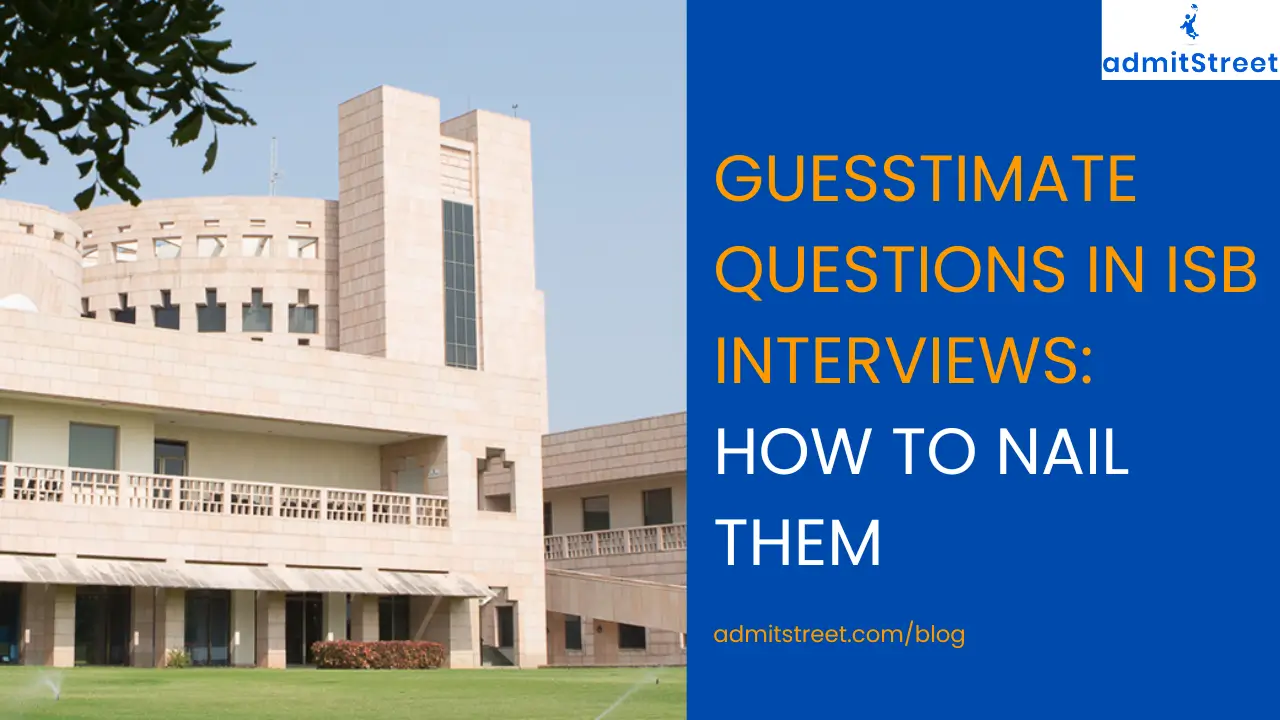Guesstimate Questions are among the ‘curveballs’ that some ISB interviewers throw at candidates.
These questions are particularly likely if your post-MBA goal is consulting and/or your interview panel includes a current or former consultant.
This article explains what guesstimate questions are, provides frameworks for tackling them, outlines a high-level approach to solve them, and includes actionable tips along with 3 examples of guesstimates.
What is a guesstimate?

A guesstimate combines ‘guess’ and ‘estimate,’ requiring candidates to approximate a number or quantitative variable.
Market-sizing questions, a common subset, ask for estimations of a product’s market size. For instance, estimating the annual revenue of the smartphone market in India would be a typical market-sizing question.
Frameworks for Tackling Guesstimates
- Top-Down Approach: Start with a broad number (e.g., India’s population) and narrow down using logical segmentation.
- Bottom-Up Approach: Build estimates from smaller components, aggregating data points to reach the final figure.
- Demand-Supply Dynamics: For market-sizing questions, analyze both demand-side (consumer needs) and supply-side (available resources) factors.
Crack Guesstimates for Top B-Schools
Guesstimate questions are common in MBA interviews at schools like ISB, INSEAD, IIMs, and more.
Approach to Solving Guesstimate Questions

A structured methodology is crucial for tackling guesstimate questions effectively:
- Clarify the Problem: Begin by defining ambiguous terms and setting clear parameters. Determine the unit of measurement, timeframe, distribution channels, and target customers. For example, when estimating the number of smartphones sold annually in India, specify whether the focus is on units sold to end consumers within a particular year.
- Break Down the Problem: Divide the estimation into manageable components. This might involve segmenting the population, identifying potential customer bases, or categorizing product types. Such segmentation simplifies calculations and enhances accuracy. Use MECE (Mutually Exclusive, Collectively Exhaustive) principles to organize thoughts.
- Make Reasonable Assumptions: Base your assumptions on logical reasoning and general knowledge. For instance, if estimating the number of school teachers in a city, start with the city’s population, estimate the number of schools, and then the average number of teachers per school. Use relevant metrics such as urban-rural splits or industry benchmarks. For example, India’s urban population is approximately 35%, which may influence consumption trends.
- Perform Calculations: Use rounded numbers to simplify arithmetic and reduce errors. Clearly outline each step of your calculation to maintain transparency and allow for adjustments if necessary. Stay approximate but logical; avoid spending excessive time on precise computations.
- Validate (Sanity Check) and Present Your Answer: Assess the plausibility of your result by comparing it with real-world data or through logical reasoning. Conclude by summarizing your findings and explaining the rationale behind your approach.
Worried about interview prep? We have got you covered with a comprehensive list of MBA interview questions by school.
Don’t miss this: How Arnab cracked the ISB PGP interview – real insights, challenges, and tips from his journey.
Solved Examples of Guesstimates
Here are some examples of guesstimate questions with structured solutions:
Example 1: What is the annual revenue of tea consumption in India?
Step 1: Clarify the Problem
- Define “tea consumption” as total tea sold and consumed in India annually.
- Include retail and small outlets but exclude exports.
Step 2: Break Down the Problem
- Estimate the population of India.
- Assume the percentage of tea drinkers in India.
- Calculate the average number of cups consumed daily by a tea drinker.
- Estimate the average price per cup of tea.
Step 3: Estimate Each Component
- India’s population: ~1.4 billion.
- Percentage of tea drinkers: ~70%.
- Cups per day per tea drinker: ~2 cups.
- Price per cup: ₹10 (average across urban and rural areas).
Step 4: Calculate the Estimate
- Total cups consumed annually:
1.4 billion×70%×2 cups/day×365
= ~715 billion cups per year.
- Total annual revenue:
715 billion cups×₹10 per cup
= ₹7.15 trillion.
Step 5: Sanity Check
Cross-check with known industry estimates (e.g., tea market reports) for reasonableness.
Example 2: How many smartphones are sold annually in India?
Step 1: Clarify the Problem
- Define “smartphones sold” as new purchases within a year.
- Focus only on India, excluding imports for personal use.
Step 2: Break Down the Problem
- Estimate the population of India.
- Calculate the percentage of smartphone users.
- Estimate the replacement cycle for smartphones.
Step 3: Estimate Each Component
- India’s population: ~1.4 billion.
- Smartphone penetration: ~50%.
- Replacement cycle: ~2 years.
Step 4: Calculate the Estimate
- Total smartphone users: 1.4 billion×50%=700 million.
- Annual sales: 700 million÷2 years=350 million smartphones/year
Step 5: Sanity Check
- Check if this aligns with data from smartphone manufacturers or industry reports.
Example 3: How many pizzas are sold in a city like Mumbai annually?
Step 1: Clarify the Problem
- Define “pizzas sold” as all pizzas sold through restaurants, delivery services, and retail outlets.
Step 2: Break Down the Problem
- Estimate Mumbai’s population.
- Calculate the percentage of the population that eats pizza.
- Estimate the average number of pizzas consumed per person annually.
Step 3: Estimate Each Component
- Mumbai’s population: ~20 million.
- Percentage eating pizza: ~30% (urban, diverse population).
- Pizzas per person annually: ~10 (one every 5 weeks).
Step 4: Calculate the Estimate
- Total pizzas sold annually:
20 million×30%×10=60 million pizzas/year
Step 5: Sanity Check
Cross-check against sales data from major pizza chains (e.g., Domino’s, Pizza Hut) in Mumbai.
Tips for Guesstimate Questions
- Use Benchmarks: Use population data, consumption habits, and pricing to ground assumptions in reality.
- Adjust for Urban/Rural Divide: Urban and rural populations have vastly different consumption patterns.
- Rely on Local Examples: Examples like tea, smartphones, or public transport resonate well for cases.
- Leverage Common Metrics: Data like population percentages, daily/weekly habits, and average ticket sizes simplify assumptions.
Struggling with your MBA resume? Here’s a guide to help you stand out to top business schools.
Common Guesstimate Mistakes to Avoid

- Jumping to an Answer: This is the biggest red flag. It shows a lack of structured thinking.
- Using Unrealistic Assumptions: Saying “Let’s assume India’s population is 500 million” will derail your entire calculation.
- Getting Stuck on Perfect Accuracy: It’s called a guesstimate for a reason. It’s about a logical path to a reasonable ballpark figure.
More About ISB
You may be interested in exploring more about ISB:
- ISB Interview Tips
- How to Get into ISB: A 5-Step Process (2025)
- ISB Letter of Recommendation (LoR)
- ISB Essay Analysis & Tips
- ISB Placements: Insights & Trends
- A Comprehensive Guide to ISB Scholarships
- ISB Reapplication Guide
- ISB WAT Preparation Guide
- ISB vs IIM: Which is Right for You?
- ISB PGP Young Leaders Program (PGPpro/PGPYL)
Key Takeaways & Cheat Sheet
- Embrace Approximations: Round numbers are your friend.
- The Framework is King: Always use the 5-step method – Clarify, Break Down, Assumption, Solve, Sanity Check.
- Process Over Answer: Your structured thinking is what gets you the admit.
- Practice Out Loud: Simulate the interview environment as you practice.
Remember, if your ISB interviewer throws a guesstimate question at you, the goal isn’t to be numerically accurate to 2 decimal points, but to showcase your structured problem solving, common-sense (assumptions) and back-of-the-envelope calculations to arrive at a reasonably accurate answer.
Hope this helps some. Happy ‘guesstimate’ time.
FAQs – Guesstimate Questions
What exactly is a guesstimate question?
A guesstimate question is a type of case interview question where you are asked to estimate an unknown quantity using logic, reasoning, and simple assumptions. The primary goal is not to arrive at a perfectly accurate answer, but to demonstrate your structured thinking, numerical ability, and problem-solving skills under pressure.
Why does ISB ask guesstimate questions in interviews?
ISB uses guesstimate questions to assess a candidate’s analytical prowess and comfort with ambiguity. They want to see if you can break down a complex, real-world problem logically—a critical skill for any business leader or manager. It tests your ability to “think on your feet.”
What is the best framework to solve a guesstimate?
The most effective and widely recommended framework is a simple 4-step process:
1) Clarify: Ask questions to ensure you understand the problem scope.
2) Break Down: Deconstruct the main problem into smaller, manageable parts.
3) Solve: Make reasonable assumptions and solve each part with simple math.
4) Sanity Check: Consolidate your answer and verify if the final estimate makes logical sense.
Are guesstimates asked in all ISB interviews (PGP, YLP, PGPpro)?
While not guaranteed in every single interview, they are extremely common, especially for the PGP program. For YLP and PGPpro, the questions might be slightly adjusted for experience level, but the core objective of testing analytical thinking remains. It’s best to be prepared for them regardless of the program.
How can I make my assumptions sound credible?
Base your assumptions on general knowledge and common sense. You can anchor them to known facts (e.g., “The population of India is approximately 1.4 billion,” or “From my experience, a typical coffee shop can seat about 30 people.”). Briefly justifying your assumption by saying “I am assuming this because…” adds credibility.
What if my final estimate is completely wrong?
The numerical answer is the least important part. Interviewers are far more interested in your structured approach and logical journey. A “wrong” number derived from a sound process is much better than a “correct” number reached through guesswork. Always focus on showcasing your method.
What are some common guesstimate topics I should practice?
Common themes include:
Market Sizing: “Estimate the market size for electric vehicles in India.”
Volume Estimates: “How many smartphones are sold in Mumbai in a year?”
Everyday Scenarios: “How many cups of tea are consumed in Delhi daily?”
Revenue Calculations: “Estimate the monthly revenue of a popular restaurant in your city.”
Can I use pen and paper during the interview for calculations?
Yes, most often you can. It is perfectly acceptable to ask the interviewer, “Would it be alright if I used a notepad to jot down my structure?” Using pen and paper helps organize your thoughts and avoids mental calculation errors.
Get a free profile evaluation
If you would like a candid assessment of your profile, fill in your details through the link below.


